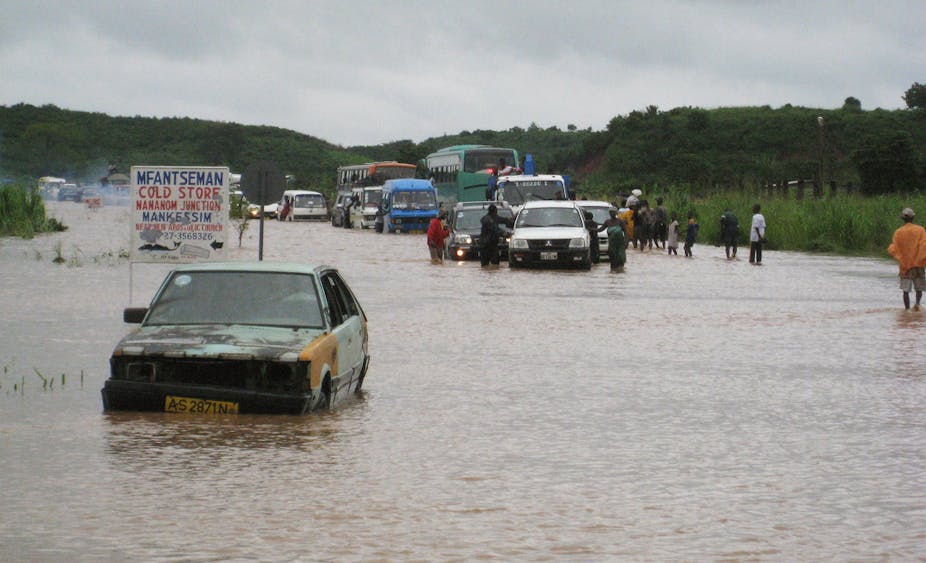Ghana has a serious flood problem. Over about 50 years, 4 million people have been affected by floods, resulting in economic damage exceeding USD$780 million. At least one major flood disaster has occurred every year over the past 10 years.
Floods are not uncommon in West Africa. Rainfall variability and land use changes have made them increasingly common throughout the region.
In Ghana’s urban areas, like Accra and Kumasi, floods are mostly triggered by seasonal rainfall combined with poor drainage, the dumping of waste into waterways and the low elevation of settlements. In northern Ghana, some floods are caused by spillage from a dam in Burkina Faso.
The floods expose communities to health risks, food shortages and mental stress.
The problem is Ghana’s government currently reacts to the floods using coping strategies. These don’t deal with the underlying risks, are expensive and don’t consider that floods will get worse. The government must take steps towards more proactive flood risk management.
Reactive strategies
After every flood, the country’s national disaster management organisation – along with the military, police, and other emergency personnel – is deployed for rescue and emergency relief.
The government then repairs damaged infrastructure, clears waterways and demolishes properties built close to drainage channels.
The problem is this doesn’t deal with the underlying causes of the floods, or prepare people for them. Money that could go towards future prevention is instead spent on perpetual cycles of recovery.
These coping strategies will get more costly because the flood risk is set to get worse. The amount of rainfall classified as “heavy” is projected to increase between 2010 and 2050, with the wet seasons projected to get wetter and the dry seasons drier.
This will be felt intensely in the urban areas as populations continue to grow. Already, about 40% of Accra is classified as “highly prone” to flooding. This will increase as, due to more building, less water will drain into the soil.
The case for flood risk adaptation
The government needs to make the country more resilient and able to withstand the challenges posed by intense and frequent floods.
Ghana participates in a variety of adaptation programmes. Like the resilient cities network and the Africa Adaptation Program. But this hasn’t translated into action.
The government has also taken on projects to protect against floods, but these are focused on the coastal areas. For example the Keta sea defence project.
The current greater Accra Metropolitan Area sanitation and water project is constructing drains and culverts in Accra. But this isn’t a major part of the project.
Much more needs to be done. Ghana must fully transition from coping strategies, to proactive, long-term measures. These include:
Structural flood protection measures – like storm drains or levees. These need to be constructed to protect all at risk areas, and not just the coastal areas
Improve early warning systems to ensure timely flood risk alerts. This should include; a 24 hour monitoring and warning service during peak rain seasons and an education program to help communities understand the risk, respect the warnings and know how to respond
Social protection – like affordable social housing – which will move more people out of informal settlements built in flood prone zones
Strategies aimed at improving the natural environment – for example, creating riparian buffer zones that protect and expand wetlands so that vegetation slows and absorbs flood waters
Encourage households to adapt and advise on actions they can take, like using more water resistant building materials
Restore lagoons and rivers
Proper waste management. Ghana has a huge solid waste problem. Poor disposal of solid waste often leads to the blocking of drains and drainage systems, preventing flood waters from flowing through
Moving homes and businesses out of flood prone locations. They can choose to do this, or the government can facilitate it by buying out at-risk properties
Build new homes on elevated ground or foundations
Strict planning to avoid construction in flood-prone areas
Deal with spillage from dams by building canals that channel the water. These can be dammed and the water used for irrigation.
The initial cost of adaptation measures will be expensive, but it will pay off. Research shows that for every US$1 spent on flood risk reduction, it saves at least US$4 to US$9 otherwise spent in an emergency response when disaster occurs. The Netherlands is a classic example of a country that has taken flood risk adaptation seriously. A quarter of the country is below sea level and 60% of its people in flood-risk areas but the measures it has taken have reduced the likelihood of major flooding.
Ghana can take advantage of predictions and past experiences of floods to aggressively pursue flood risk adaptation. Failure to do this will increase flood disasters, and social and economic disruptions.

